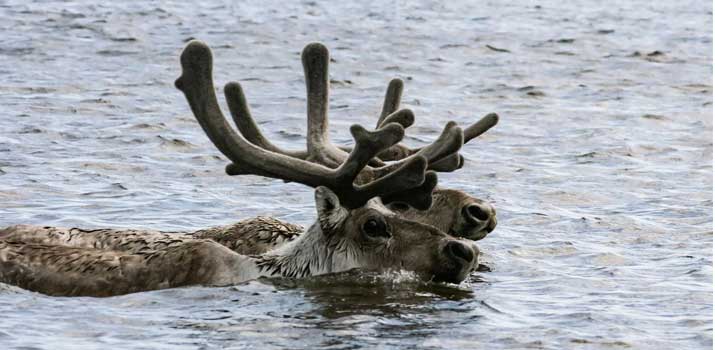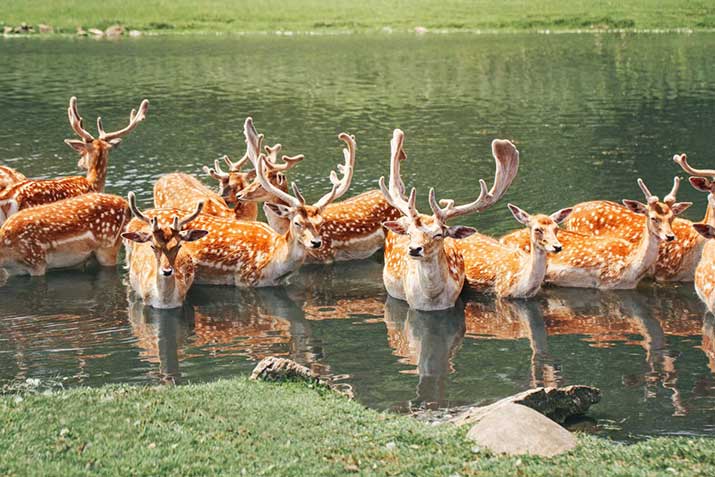
When we think of deer, we picture them prancing through meadows of wildflowers; nuzzling aside rusty autumn leaves to forage for food in twilight; or perhaps having a slurp, sending ripples expanding across an otherwise still lake.
But swimming in said lake… not so much.
Perhaps it’s because those cloven hooves of theirs don’t look all that great for paddling, or maybe it’s that we simply never catch a glimpse of them in water, but we just don’t really consider the majestic deer an aquatically gifted animal.
Yet, they can indeed swim. They may have been made with swiftness by land in mind, but they won’t hesitate to have a paddle if need be.
Are Deer Good Swimmers?
Despite their sleight, willowy frames, deer are surprisingly adept swimmers, as, though their muscles are lean, they’re incredibly strong.
As they would on land, they often travel through water with their herd, sometimes traversing great distances without breaking a sweat.
They have also been known to swim alone if the need arises.
Why Do Deer Need To Swim?
There are a number of reasons why a deer might decide to take an impromptu bath in a body of water, of which – surprisingly – bathing isn’t one.
Deer much prefer to groom themselves with their tongue a la your pet cat than to wash off in a lake or river.
The Hunt For Food
Deer often have to cross bodies of water in the perpetual search for food.
Once they’ve foraged one section of land, they must move on to the next until that too is depleted, and so on.
They no doubt consider circumnavigating a body of water when they arrive at one, but it’s commonly quicker to brave the chilly depths and swim to land on the other side than it is to walk around.
To Escape Predators
While deer are insanely agile on land, running isn’t always enough to escape the jaws of a particularly relentless predator.
Sometimes, swimming to safety is the only option, and so they do, remarkably well I hasten to add.
It’s no surprise really when you think about it… if the difference between getting eaten and living on is the ability to swim, you get learnin’ pretty darn fast I imagine.
How Fast Can Deer Swim?

Now, you may have read that last paragraph and thought to yourself… can’t the predators of deer swim too?
Well, you’d be correct; many of this animal’s natural predators are indeed strong swimmers, but you know what that means, don’t you?
Deer have to be even stronger swimmers!
For instance, let’s say that a herd is being tailed by a ravenous brown bear.
Such a carnivore can run at about 35 miles per hour, which is around the same speed as deer, so there’s a very good chance that at least one of the herd would be caught.
But get this… bears can only swim at approximately 6 mph, which is roughly the same as trained humans.
Deer, by contrast, can reach speeds up to a whopping 15 miles per hour in water, giving them a huge advantage and the best chance of escaping.
This is one of the reasons why recent studies have shown that deer often repose near water.
In fact, large buck beds typically fall within about 75 yards of a water source, providing drinking water and a nifty escape route should the brown bear with a grumbling belly stumble across their bed.
Are All Deer Excellent Swimmers?
It stands to reason that there have always been deer with exceptional swimming skills.
Through natural selection, these aquatic genes have been passed on time and time again until entire populations of deer can traverse giant bodies of water in record time.
In other words, that hypothetical bear we spoke of earlier caught all the bad swimmers and ate them, so their suboptimal genes would never be passed on.
It’s Also A Matter Of Anatomy
Even deer that aren’t strong swimmers have a secret weapon when they hit the water, or should I say two secret weapons?
The heart and lungs of a deer are wildly disproportionate to their slender body, meaning their muscles get plenty of blood and oxygen during the rigors of swimming long distances very quickly.
Combine this with their aqua-dynamic form capable of cutting through the water like Captain Nemo’s Nautilus, and it’s no surprise they’re capable of swimming 15 miles per hour, even though this seems at first to be an unrealistic pace for such an animal.
Are they primarily terra dwellers? Absolutely, but it’s precisely the attributes that make them so nimble on land that make them a force to be reckoned with when they take to water.
Can Baby Deer Swim?
Deer babies, otherwise known as fawn, are capable swimmers, but they probably won’t outswim our full-grown brown bear.
What’s more, they won’t be able to swim as far as their parents, so they’re limited to crossing relatively modest bodies of water.
Are There Any Species Of Deer That Can’t Swim?
It’s understood that all species of deer can swim very well, but that’s not to say that there aren’t certain species more adapted to traveling through water than others.
Two such species are known as the Korean water deer and the Chinese water deer.
The former are rife in their native Korea, as all of their natural predators teeter on the brink of extinction.
The latter is only found in a few rural regions of their native China, but thanks to conservation efforts, there are now healthy feral populations in both the US and the UK.
Final Thoughts
Deer may prefer solid ground, but they’re aware of the technical advantage a body of water can provide in an emergency as they’re fantastic swimmers capable of soaring through the water at an impressive 15 miles per hour.
Thanks to a favorable organ size-to-body mass ratio, their blood and muscles remain highly oxygenated, increasing buoyancy and decreasing fatigue, meaning they’re just as good at swimming far as they are swimming fast.
